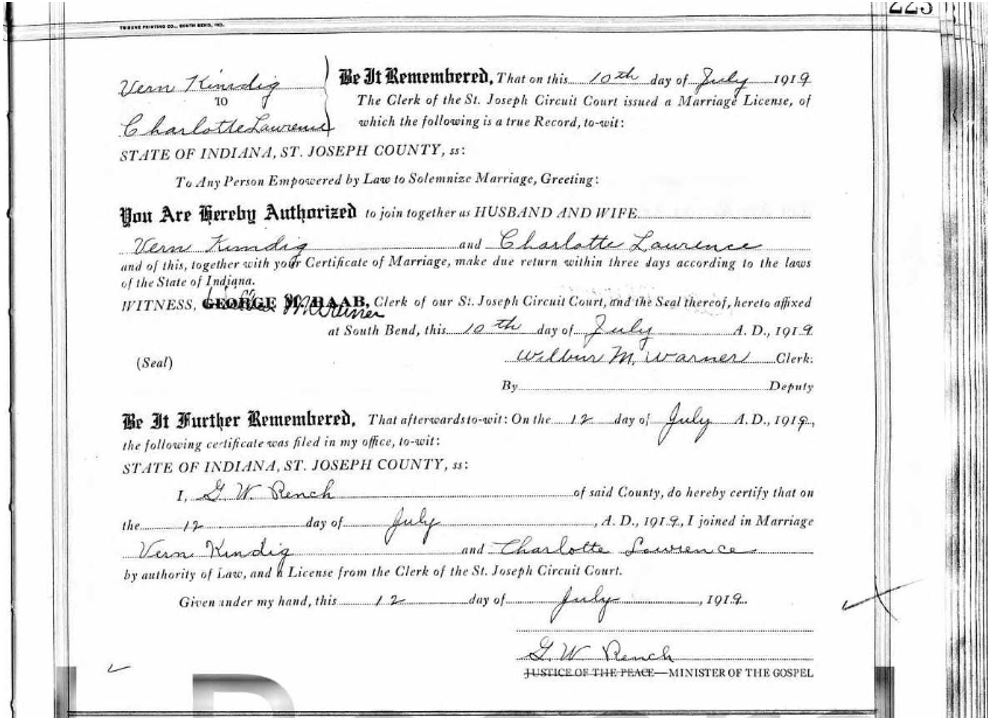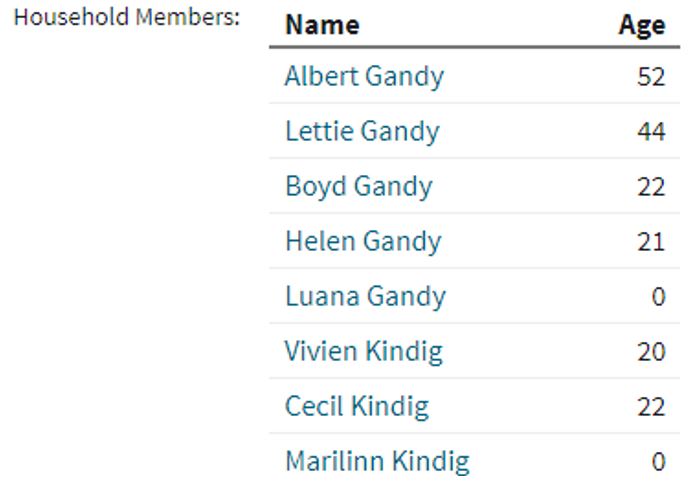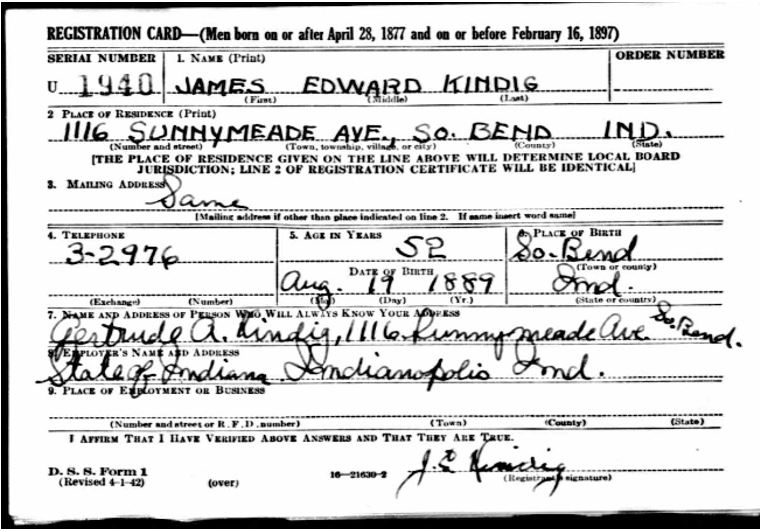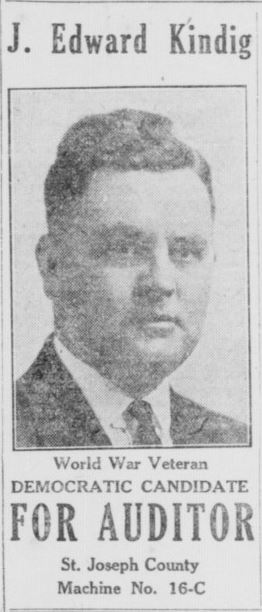From the Vault | The Kindig Mystery
By Jessica Petty
One of our virtual volunteers for our World War One (WWI) service card transcription project noticed several soldiers who enlisted around the same time with the last name Kindig from South Bend, Indiana. They also all seemed to be from the same place, Union City, Michigan. We decided to investigate and see if we could figure out the mystery! (Note: All images are taken from Ancestry.com, except the “J. Edward Kindig for Auditor” newspaper clip.)
In researching these names, our first breakthrough was a 1910 Census record that puts four of the five Kindigs in the same household.
Ephiram (with different spellings everywhere you look) and Myrtle Kindig appear to have moved from Union City, Michigan with at least one of their children. They settled in South Bend and founded the family that piqued our curiosity. We’ll talk about their children from oldest to youngest, with the fifth unrelated Kindig last, and two bonus Kindigs at the end.
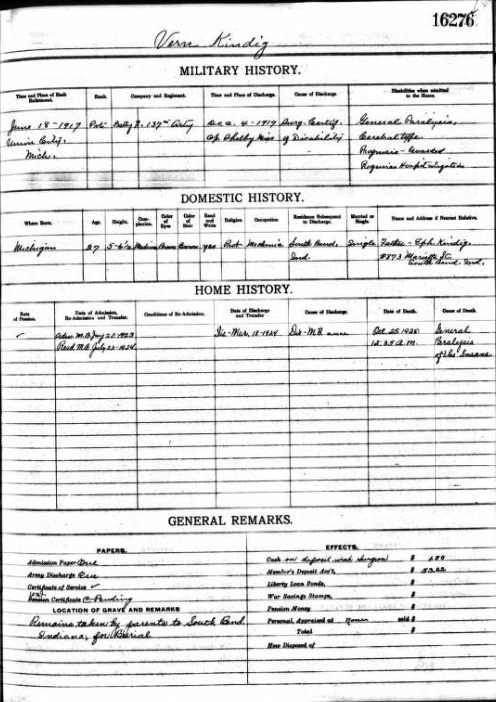
Vern Kindig (sometimes listed as Verne) was the oldest child. A 1917 article in the South Bend News-Times, listed him as a former pupil of Franklin School, a South Bend elementary school. In the same article, his brother Cecil was also listed as a former pupil (more on him later). Before Vern’s service in the war, which began on June 18th, 1917 (one day after his brother Cecil joined), Vern married Marie Yeagley. The couple are listed in the 1916 South Bend City Directory (where all our Kindigs and some others are mentioned). Marie was granted a divorce from Vern in 1916 on the charge of “abusive and cruel treatment.” Vern then remarried Charlotte Lawrence in 1919 (see above).
According to the 1920 Census, Vern and Charlotte were living in their in-law’s house. Vern had a job as a machine operator at the Motor Wheel Company. However, a 1922 newspaper article stated that Charlotte was granted a divorce. She told authorities that Vern “threw her violently out of the house” and “called her vile names, beat and kicked her.” The story gets even more complicated. A record notes that Vern was admitted to a home for disabled veterans in 1923, (where his service in the 137th Artillery during WWI was listed). The record attributed his death in 1928 to “General paralysis of the insane.” It is worth noting that his WWI service card (linked above on the date of his enlistment) described that he was 25% disabled upon his leaving the army. Vern may have suffered from Post-Traumatic Stress Disorder (PTSD) or some other underlying issue from the war (or even earlier) that never received proper treatment.
The second oldest brother was Lisle Kindig. He is harder to track in the historical records. He enlisted on December 12, 1917, the same day as his younger brother Carlton. In the 1920 Census, he lived at home as a 23 year old, with his name listed as “Lyle”. There were multiple misspellings of his name in different records. In the 1920 Census, he is listed as a sign painter. Despite being the second oldest, we found the least information about him, as he is not mentioned in the household’s 1930 Census.
The second youngest brother was Cecil Kindig, who was at Camp Shelby in Mississippi in 1918. He enlisted on June 17th, 1917. He is also mentioned in the article on Franklin School with his brother Vern.
In the 1920 Census (left), he is listed as living at his in-law’s house, with wife Vivien, and newborn daughter Marilinn. Interestingly, it appears another couple was living in the house alongside Vivien’s parents. Boyd and Helen Gandy (Vivien’s maiden name) are listed along with a newborn daughter Luana Gandy. It is likely that Boyd was Vivien’s brother. In this census, Cecil was listed as a repair man in a garage. By the 1930 Census, however, Cecil is listed back at home with his parents, as a 32 year old. We’re not sure if he was single due to a divorce or being widowed, nor do we know the fate of his child. He is listed as the proprietor of a Radio Shop in this census.
The youngest brother Carlton Kindig (sometimes written as Carolton) was listed as 17 years old and living at home in the 1920 Census. However, the service card we have for Carlton lists his age at 18, enlisting on December 12, 1917. It could be that he faked his age in order to serve, or that the birth year is wrong in the Census. In the 1940 Census, Carlton is listed as married to Ruth Fortin and living in South Bend as a “Manager”. It is also stated that his education is “High school, 3rd year”. This supports the hypothesis that he faked his age and dropped out in order to enlist.

We also found a death certificate for Carlton (right), listing his age as 94 (he died in 1996) and cause of death as pneumonia. In addition, I found an obituary for Carlton Ephraim Kindig Jr (Remember that Ephraim is the name of the Kindigs’ father). It confirms other information located, as Jr’s parents are listed as Carlton and Ruth Kindig. He was also a lifelong resident of South Bend, living from 1934 to 2013. Carlton Sr. and Ruth had four other children.
The fifth South Bend native with a Kindig surname in the WWI registration cards (left) was James Edward Kindig. He was the only Kindig not related to the other four. He enlisted on April 27, 1918. After he returned home from the service in 1919, the newspaper reported that during the war he was “detailed to a theatrical troupe composed entirely of doughboys which gave vaudeville performances at all of the leading rest camps in France.” Not only this, but “Due to his slim figure and tenor voice, the sergeant was given the part of a girl to play.” He was married to Gertrude Dienhart in 1920, and she survived him until 1991.
James, or Edward (which he evidently preferred), was also active in civil service. He ran for auditor (image left) of St. Joseph County in 1922, but lost. According to his obituary (below), he served in the Rainbow Division, 344 Field Artillery during WW1 and was the district manager of Indiana Gross Income Tax Division for 16 years. In addition to this information, we found his service card for World War II (see right). It is not mentioned in his obituary (or in the newspapers that we searched) but he signed up in 1940 and was in the Navy during World War II. He served on the USS Shangri-La, and is listed on the muster rolls of that ship in 1946. He died in 1954, at 64 years old.
Bonus!
Gertrude Kindig was the fifth child in the Kindig family and was listed as living in the house with her older brothers in the 1910 Census (before the sixth and seventh children, Evelyn and Esther, were born – they are mentioned in the 1920 Census.) While we found two Gertrude Kindigs in the censuses, including James Edward’s spouse, it’s always important to consider who is who in the census, and just because you find the same names, it does not always mean that it’s the same person. Keep in mind that James Edward Kindig married Gertrude Dienhart. She was born in Lafayette, Indiana, and was a school teacher in South Bend most of her life (obituary here).
The “Kindig” Gertrude, whom I found a death certificate for, died in 2011 at the age of 92, listed as widowed Gertrude Martin. She also lived in South Bend her entire life.
Another coincidence, Vernon Kindig has a service card in our collection, but is a different person than Vern/Verne. He was married to Geneva (Neva) Personette in 1920, according to his obituary and the 1920 Census. He lived in Akron, Fulton County, Indiana and died in 1941.
The Kindig family is an extremely interesting look into the great interest Hoosiers had in serving in WWI, and how family ties and geographical ties were abundant. Although four of the five Kindigs from South Bend were related, our service card collection includes thirteen total men with the last name Kindig from all over the state, and newspapers from South Bend place many other Kindigs in that city before and after the war. Their stories are just some of thousands that can be discovered because of the efforts of our transcription virtual volunteers! If you have any information on the Kindig Family, have a story you want to share, or want to help transcribe WWI Service Cards, feel free to contact us at arc@iara.in.gov!



